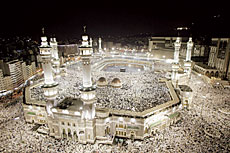by Dr. Zakir Naik | |
I INTRODUCTION TO HINDUISM: | |
The most popular among the Aryan religions is Hinduism. ‘Hindu’ is actually a Persian word that stands for the inhabitants of the region beyond the Indus Valley. However, in common parlance, Hinduism is a blanket term for an assortment of religious beliefs, most of which are based on the Vedas, the Upanishads and the Bhagavad Gita. | |
II INTRODUCTION TO HINDU SCRIPTURES. | |
| There are several sacred scriptures of the Hindus. Among these are the Vedas, Upanishads and the Puranas. | |
1. | VEDAS: |
| |
2. |
|
| |
3. |
|
Next in order of authenticity are the Puranas which are the most widely read scriptures. It is believed that the Puranas contain the history of the creation of the universe, history of the early Aryan tribes, life stories of the divines and deities of the Hindus. It is also believed that the Puranas are revealed books like the Vedas, which were revealed simultaneously with the Vedas or sometime close to it. Maharishi Vyasa has divided the Puranas into 18 voluminous parts. He also arranged the Vedas under various heads. Chief among the Puranas is a book known as Bhavishya Purana. It is called so because it is believed to give an account of future events. The Hindus consider it to be the word of God. Maharishi yasa is considered to be just the compiler of the book. | |
4. |
|
The two epics of Hinduism are the Ramayana and the Mahabharata. A. Ramayana: According to Ramanuja, the great scholar of Ramayana, there are more than 300 different types of Ramayana: Tulsidas Ramayana, Kumbha Ramayana. Though the outline of Ramayana is same, the details and contents differ. Valmiki’s Ramayana: Unlike the Mahabharata, the Ramayana appears to be the work of one person – the sage Valmiki, who probably composed it in the 3rd century BC. Its best-known recension (by Tulsi Das, 1532-1623) consists of 24,000 rhymed couplets of 16-syllable lines organised into 7 books. The poem incorporates many ancient legends and draws on the sacred books of the Vedas. It describes the efforts of Kosala’s heir, Rama, to regain his throne and rescue his wife, Sita, from the demon King of Lanka. Valmiki's Ramayana is a Hindu epic tradition whose earliest literary version is a Sanskrit poem attributed to the sage Valmiki. Its principal characters are said to present ideal models of personal, familial, and social behavior and hence are considered to exemplify Dharma, the principle of moral order. B. Mahabharata: The nucleus of the Mahabharata is the war of eighteen days fought between the Kauravas, the hundred sons of Dhritarashtra and Pandavas, the five sons of Pandu. The epic entails all the circumstances leading upto the war. Involved in this Kurukshetra battle were almost all the kings of India joining either of the two parties. The result of this war was the total annihilation of Kauravas and their party. Yudhishthira, the head of the Pandavas, became the sovereign monarch of Hastinapura. His victory is supposed to symbolise the victory of good over evil. But with the progress of years, new matters and episodes relating to the various aspects of human life, social, economic, political, moral and religious as also fragments of other heroic legends came to be added to the aforesaid nucleus and this phenomenon continued for centuries until it acquired the present shape. The Mahabharata represents a whole literature rather than one single and unified work, and contains many multifarious things. C. Bhagavad Gita: Bhagavad Gita is a part of Mahabharata. It is the advice given by Krishna to Arjun on the battlefield of Kurukshetra. It contains the essence of the Vedas and is the most popular of all the Hindu Scriptures. It contains 18 chapters. The Bhagavad Gita is one of the most widely read and revered of the works sacred to the Hindus. It is their chief devotional book, and has been for centuries the principal source of religious inspiration for many thousands of Hindus. The Gita is a dramatic poem, which forms a small part of the larger epic, the Mahabharata. It is included in the sixth book (Bhismaparvan) of the Mahabaharata and documents one tiny event in a huge epic tale. The Bhagavad Gita tells a story of a moral crisis faced by Arjuna, which is solved through the interaction between Arjuna, a Pandava warrior hesitating before battle, and Krishna, his charioteer and teacher. The Bhagavad Gita relates a brief incident in the main story of a rivalry and eventually a war between two branches of a royal family. In that brief incident - a pause on the battlefield just as the battle is about to begin - Krishna, one chief on one side (also believed to be the Lord incarnate), is presented as responding to the doubts of Arjuna. The poem is the dialogue through which Arjuna’s doubts were resolved by Krishna’s teachings. Reference: http://www.irf.net/irf/comparativereligion/index.htm | |
Islam - The Religion From God
INTRODUCTION TO HINDUISM
- Details
- Hits: 11362
